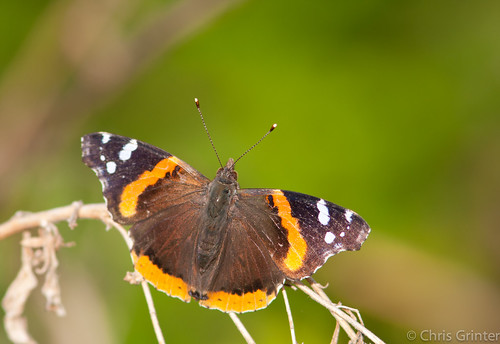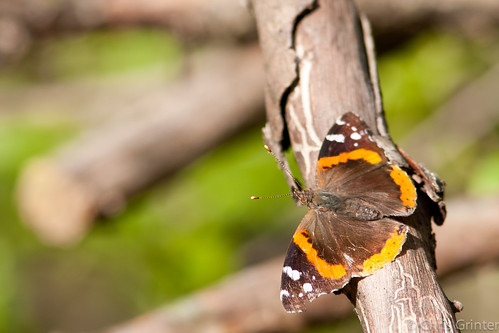habari za mitaa kwa zaidi ya Marekani mashariki na Canada imekuwa aflutter (ina) recently with reports of the irruption of Vanessa atalanta – Butterfly Red Admiral. Wakati huu ni tukio la kawaida kila spring kwa vipepeo hawa kuhamia kaskazini kutoka maeneo yao ya overwintering katika Marekani ya kusini, idadi kubwa ya mwaka huu inashangaza. Kuna maelfu ya maajabu katika yadi zetu za nyuma.
Kwa hivyo ni nini tofauti mwaka huu?
Kuna maoni mengi juu ya hali ya hewa ya joto ya msimu wa joto (joto zaidi Machi kwenye rekodi kwa maeneo mengi) na mara nyingi habari nyingi potofu kwenda pamoja na entomology ya kiti cha armchair. Vyanzo vingi vya habari ambavyo nimepata kusema chemchemi ya joto imeruhusu vipepeo hivi kushamiri na kuzaa kwa idadi isiyo ya kawaida. Hiyo haiwezekani kabisa hata hivyo, V. atalanta overwinters as an adult. The southern states provide temps just warm enough for adult Vanessa butterflies to hide in the fall and be the very first to awaken in the spring to get a jump start on mating. Hata kama vipepeo walikuwa wameamka mnamo Februari mimea ya mwenyeji haikuwa bado imeinuka (miiba); vipepeo katika yadi yetu ni kutoka mwaka jana.
Lakini vipi ikiwa hali ya hewa ilichukua jukumu katika mzunguko huu wa boom? Mwaka jana ulikuwa mwaka wa La Niña na msimu wetu wa baridi mzuri na mpole. Mwaka uliopita ilikuwa El Niño, most of the eastern US was assaulted with winter and we suffered at the hands of the epic Chicago “snowpocalypse”. Labda mchanganyiko huu umeshuka idadi ya watu vya kutosha katika 2010/2011 ambayo ilipungua mzigo wa vimelea, kuruhusu upana zaidi wa kipepeo katika msimu wa joto wa 2011. Vipepeo hao waliopindukia walipewa majira ya baridi kali ambayo ingeweza kuruhusiwa kwa vifo vya chini vya msimu wa baridi. As the butterflies moved north this spring there were no frosty nights to cut into populations – just lots of hungry birds. Matokeo yake itakuwa utitiri usiokuwa wa kawaida wa vipepeo wanaohama.
But then again…
Despite butterflies being so popular and well studied there doesn’t seem to be a perfect grip on what conditions each of the Vanessa species prefer. Vigezo vya mimea ya mwenyeji, idadi ya idadi ya watu, hali ya hewa na vimelea vyote vina jukumu muhimu kwa wingi na usambazaji. Did the weather cycles of the last few years variably effect one species over another? Nani anataka mradi huo wa PhD (kutoka kuzimu)?
One of the best posts I’ve read is by Doug Taron over on gossamer Tapestry – he is skeptical of this warm weather theory. Critically this irruption is effecting only the population of the Red Admiral and any theory involving weather would also likely effect other migrant butterflies like the Vanessa virginiensis – the American Lady. He also points out that an abundant butterfly like the admiral has classic cyclical population booms and busts in sync with parasite populations. I recall another summer in the late 90’s of staggering Admiral populations. Parasites really do better explain what we see in our yards this spring. While the weather might not have caused the abundance of V. atalanta, there can be no denying that butterflies of all species have woken up much earlier this year.



As far as I recall, almost all temperate zone animals (and plants, Mimi mtuhumiwa) go thru boom and bust cycles. It’s pretty much the function/nature of the wildly variable environmental conditions of the ecosystems. Even the less common temperate zone species cycle but the effects are less noticed simply because of the lower population levels.
must have been a lovely sight, vanessa atlanta has been struggling in the UK for the past few years!!
A few years back you may have heard about the painted lady invasion in the UK very much the same as the USA i was counting well over 1000 an hour coming up the field from the english channel !
Quick question about la nina i believe the later part of 2010 was also la nina thats why the UK and northern USA had such cold weather